The first minutes of an emergency are critical in determining outcomes, so it’s imperative that accurate and detailed information quickly reaches true first responders, including management and employees onsite, as well as outside emergency services if needed.
Situational awareness – real-time information about what’s happening within an organization, or across a campus or wide geographic area – helps manage risk and triggering events – from the mundane blown fuse to the extreme life-or-death scenario to protect people and stuff.
Situational awareness also applies to business operations. It’s all about turning inefficient alarms into detailed alerts delivered to the right people on the right devices so they can deal with an unfolding situation in the right way.
In other words, key individuals, select personnel groups or entire populations are made aware of potential problems before they become costly disruptions or full-scale emergencies.
Right-now awareness in the form of detailed alerts delivered automatically via multiple devices to those most likely to be affected, as well as on- and off-site responders, improves emergency preparedness and response. “Read, hear, see and do” is our formula for risk management, made possible with automated situational awareness. The ROI is significant in terms of saving property and operational downtime time; it’s immeasurable when it comes to life safety and security.
Our latest column in Executive Insight explores the core components of situational awareness – monitoring, alerting and reporting – plus the risk management applications. Although this column focuses on health care environments, situational awareness and SARA apply to life safety, security, environmental monitoring and mass notification in virtually any type of facility or enterprise.
Click here to read the column.
